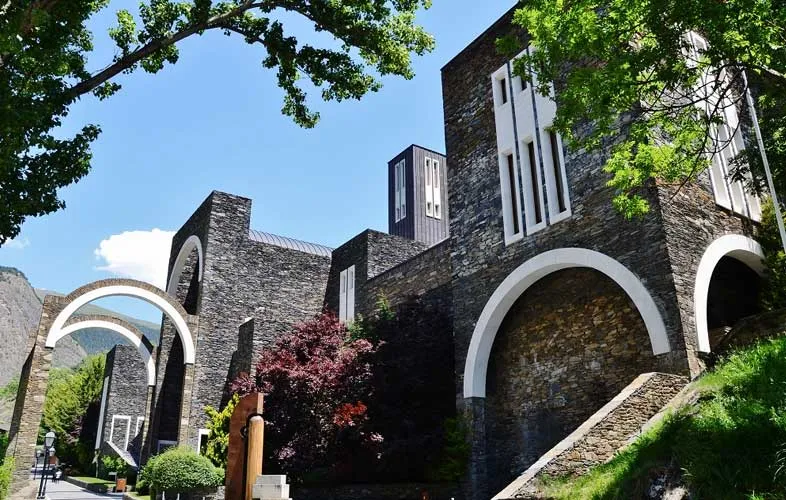
Introduction
The Sanctuary of Our Lady of Meritxell is a basilica that is located in the town of Meritxell, in the Andorran parish of Canillo. The Virgin of Meritxell, patron saint of the Principality of Andorra, is worshipped here.
In the month of March of the year 2014 it joins the Marian Route, thus completing this Great Route of cultural-religious tourism and which is framed in the Pyrenees.
The Sanctuary of Meritxell Basilica is the most important religious temple in Andorra. But as well as its spiritual importance, this place of worship in the parish of Canillo offers other reasons for a visit, in particular its art and natural surroundings.
The Meritxell religious site in Andorra is a highly symbolic place for the inhabitants of the Principality. Indeed, it houses the image of Our Lady of Meritxell, the country’s patron saint. This is a polychrome statue based on the original Romanesque work, which was destroyed in a fire in 1972.
This importance meant the temple was granted the title of minor basilica by Pope Francis in 2014, making it the only such place of worship in the Principality. Since then, Meritxell has been included in the so-called Marian Route, which connects four other important sanctuaries in Spain and France: El Pilar, Montserrat, Torreciudad and Lourdes. For this reason, the temple has become a centre for attracting visitors motivated by faith and spirituality.
The Principality of Andorra, also known as ‘The country of the Pyrenees’, is a land that holds a great cultural and historic legacy. Its inhabitants have been raised under the values of love and respect for nature. In the middle of the principality, surrounded by nature and enclosed in a scenery of great beauty, it is the Sanctuary of Our Lady of Meritxell.
History of Sanctuary of Our Lady of Meritxell, Andorra
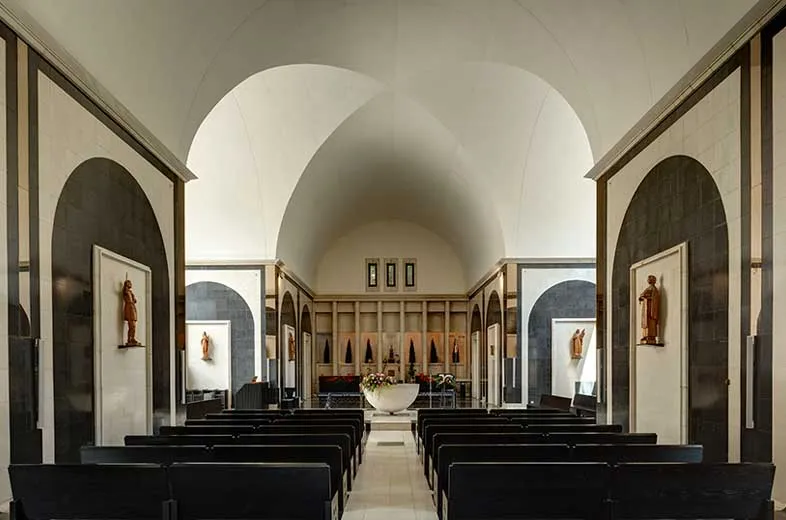
According to legend, a shepherd found the image of the Virgin one winter day under some flowering rosebushes and decided to take it home. The image, however, returned three times to the same place where it had been found. Finally, the Andorrans decided to build a chapel there.
In 1873, the General Council of the Valleys declared her patron saint of the country. On September 8, 1921, she was solemnly crowned. From then on, that day is celebrated the national holiday of the Principality.
The original sanctuary was Romanesque in style and was completely renovated in the 17th century. In 1972, the sanctuary caught fire and was completely destroyed. In the fire, the Romanesque carving of the Virgin, the oldest in the Principality, which was venerated until then, also disappeared. The construction of a new sanctuary was commissioned from the Spanish architect Ricardo Bofill Levi.
The building has a mixture of styles and aims to merge with the surrounding landscape. The new building opened in 1976. Inside, a replica of the Romanesque carving of the Virgin that was destroyed in the fire is still venerated.
The sanctuary was declared a Minor Basilica on May 13, 2014 by Pope Francis, exactly one hundred years after the pontifical declaration of the Virgin of Meritxell as the main patron saint of the Valleys of Andorra, in the time of Saint Pius X.
Architecture of Sanctuary of Our Lady of Meritxell
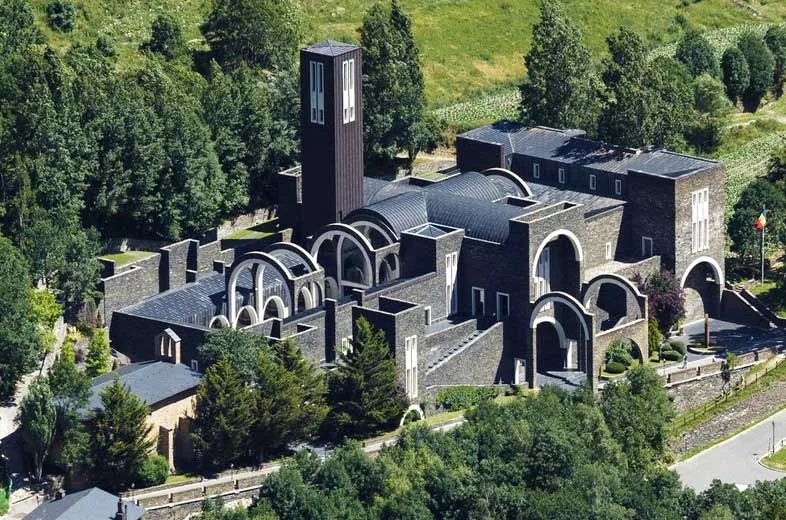
The Sanctuary of Meritxell suffered a terrible fire on September 8th of 1972. As well as destroying the statue and other objects of value inside, the sanctuary itself was almost completely ruined. Almost nothing remains of the original temple, but visitors can now admire one of the most interesting works by the renowned Spanish architect Ricardo Bofill. The result is, in his words, “a recreation of the Romanesque” style, which was present in the original church and which left a significant mark on the Principality.
The former sanctuary was rehabilitated and turned into an exhibition hall: Meritxell Memoria. Today it holds a permanent exhibition of the history and cult of Meritxell, the patron saint of Andorra.
The end result is a work in a very personal style. It is notable for its open cloister, characterised by its uncovered archways and the miracle room. The use of slate links the new basilica to its natural surroundings and the Andorran tradition. Ricardo Bofill also wanted to provide a note of contrast in luminous white, symbolising snow, which is common in this landscape during winter. The use of this colour combination also recalls typical Italian Renaissance architecture.
We can see Ricardo Bofill’s inspiration from Catalan Romanesque imagery in the large bell tower and the attached cloister covered with ribbed vaults.
Another curious feature of this sanctuary is that it has large windows that let in lots of light, and a fountain located in the middle of the cloister. Both of these characteristics recall techniques of Islamic art.
However, despite the splendour of its exterior, the inside is completely austere with no ornamentation or decoration whatsoever, apart from the stained glass window in the church revealing the meaning of the name Meritxell.
Our Lady of Meritxell
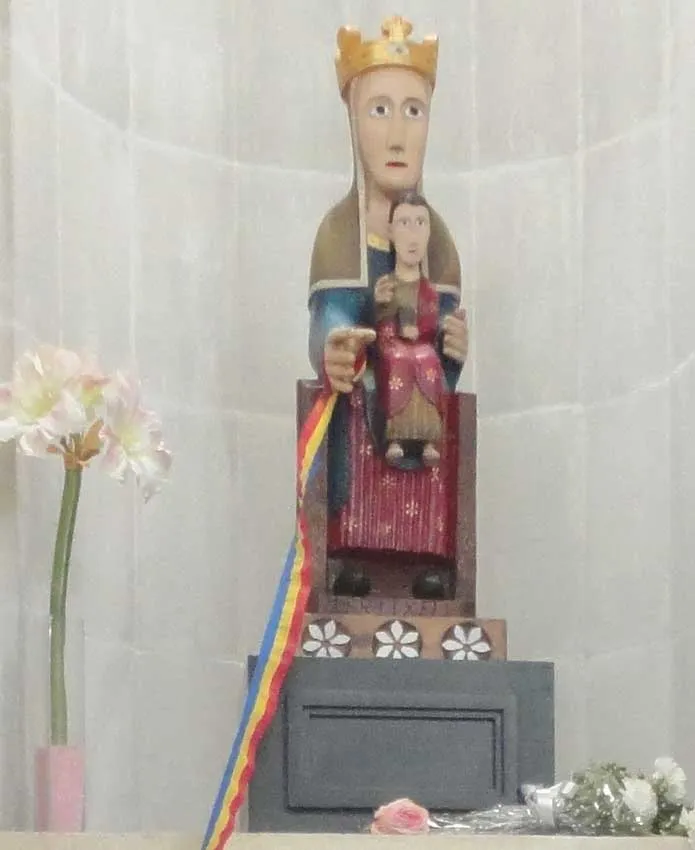
Our Lady of Meritxell is an Andorran Roman Catholic statue depicting an apparition of the Virgin Mary. Our Lady of Meritxell is the patron saint of Andorra. The original statue dated from the late 12th century. However, the chapel in which it was housed burned down on September 8 1972, and the statue was destroyed. A replica can be found in the new Meritxell Basilica, designed in 1976 by Ricardo Bofill Taller de Arquitectura.
The Catalan philologist Joan Coromines says that “Meritxell” is a diminutive of merig, from the Latin meridiem (midday in English). Merig is a name used by shepherds to denote a pasture with lot of sun. The image was canonically crowned by Pope Benedict XV on 8 September 1921.
In the late 12th century, on January 6, a wild rose in bloom was found by villagers from Meritxell going to Mass in Canillo. It was out of season and at its base was found a statue of the Virgin and Child. The statue was placed in the Canillo church. However, the statue was found under the same wild rose the next day. The statue was taken to the church of Encamp. However, as before, the statue was again found under the same wild rose on the next day. As in similar legends elsewhere, the villagers of Meritxell took this as a sign and decided to build a new chapel in their town after they found an open space miraculously untouched by the winter snows.
The Wooden Statue of Our Lady of Meritxell
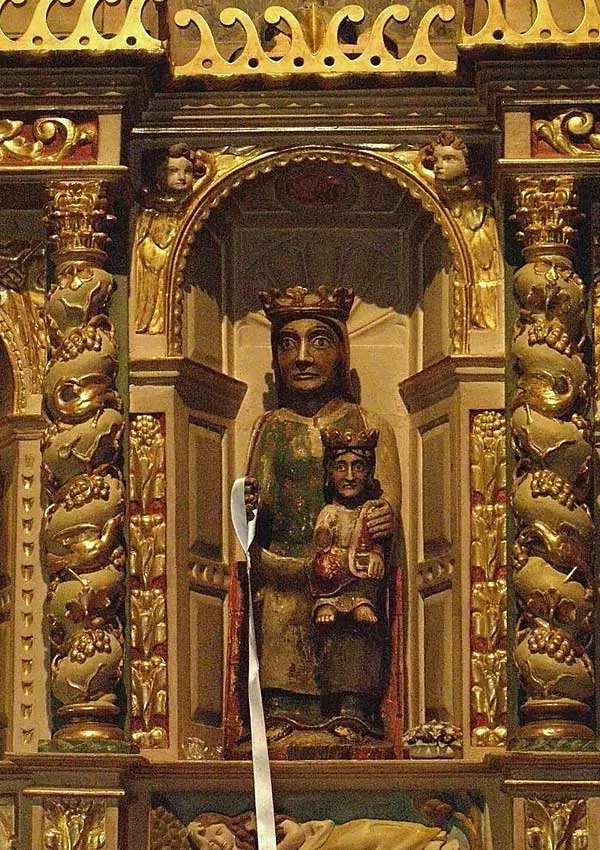
The image that can currently be seen in the sanctuary and that is venerated by the faithful and travelers is a copy of the Romanesque carving disappeared the night of September 9th 1972, in the fire that seriously affected the sanctuary.
The holly image that disappeared due to the fire was a Romanesque carving of the 12th century. Experts claim that it was one of oldest of that Pyrenean area. Sitting solemnly in hieratic attitude, holds bay Jesus in her lap, who raises his left hand, just as the Mother does. She wore a five rosette crown in her head and over a white veil that covered head and shoulders.
Museum of the Bible
The Sanctuary has an impressive collection of Bibles and New Testaments in 1,900 languages from the five continents belonging to 178 countries (it has been translated into 3,000 languages), including almost extinct languages such as Turkana, Manx, Cornish or Tetlin, ancient and modern, and some extremely rare, such as the clandestine one in North Korean, or the Bible in braille (for the blind) or in signs (for the deaf), even in manga or drawn by Robert Crumb; there are also rarities like the smallest Bible in the world or one in Minecraft video game format; all were collected and donated by former Andorran banker Pere Roquet over 26 years of continuous travel.
Other biblical museums are the Museum of the Bible in Washington DC, considered the largest in the world; the MOBIA in New York, the Museum of Biblical Art in Dallas, the Biblical Museum in Amsterdam, the Biblic Museum in Tarragona, the Biblical and Oriental Museum in León and Maná, Museum of the Bible of Mexico.
Sanctuary of Our Lady Meritxell
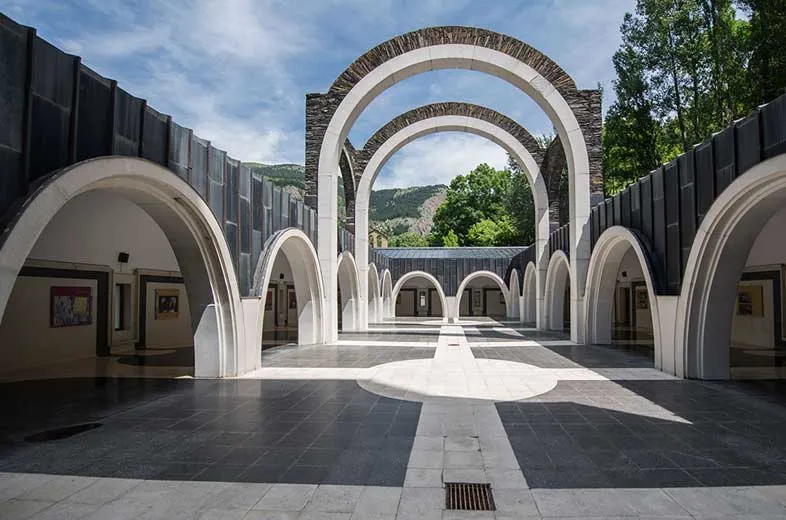
The baby Jesus, who repeats the gesture of the Mother, goes barefoot unlike the mother who wears the typical wooden flat shoes that mountain farmers used to wear. The Historic Ensemble of Meritxell is comprised of two buildings: the old Sanctuary and the new, both of them declared heritage of cultural interest.
The pope Francis granted the Sanctuary the title of Minor Basilica, in honour of its singular liturgical life, its religious work and its history and cultural activity. This recognition gives at Meritxell an incalculable religious value, the worship place most important in Andorra.
The construction of the new building was put in charge to architect Ricardo Bofill. The project had to transmit greatness, monumentality and religious strength. The project was based on three pillars: faith, identity and culture. All those concepts had to be integrated in the scenery, while being at the service of religion and culture. The original project included a great complex with buildings and elements that in the end were not erected.
The current building was inaugurated in 1976. It is a design of a modern sanctuary of eclectic conception, as some scholars pointed out, its construction reminds of constructions of other times. For some of these specialists, the bell tower looks similar to the ones present in many medieval monasteries in Southeast Europe. Also they find similarities with the Islamic (i.e.: the great visible openings present in the sanctuary, as well as by the presence of water in the cloister of mirrors). These two factors strengthen the attempt to establish a harmony between the works of men with the surrounding area.
On the other hand, the great white stone and slate arcs remind the ones left after the fire and that were part of the old church. However, the interpretation made from the architect studio, adapting to the new building the Pyrenean architectonical past is the result of the ‘interpretation of the Romanesque architecture theoretic principals within a modern design’.
Inside, the Altar is placed in the centre of the church. It has a circular shape. The Image is a reproduction of the carving of the Virgin of Meritxell done by a workshop of a lot, according to the canons of the Romanesque disappeared after the fire. On the top part, the visitor can see the statues of the seven Presiding Saints of the Andorran parishes. The presence of these saints in the temple remarks the importance of Meritxell as a National Sanctuary.
The Sanctuary of Meritxell complex has been declared of Cultural Interest for the Government of Andorra.
Origins of the Sanctuary of Our Lady of Meritxell

The origin of the Sanctuary of Our Lady Meritxell, as it happens with many other sanctuaries does not have written documentation with specific and accurate information that allows a true reconstruction of the beginning.
However, there is an evidence of the oral tradition that has passed from parents to children and that it has come to us as a beautiful legend. Just as it happens with most popular stories, this one includes a different touch depending who tells the story, but in essence, the origins of the sanctuary was pretty much as it follows:
“… from the village of Meritxell, in the morning of January 6th, the Epiphany of Our Lord Jesus Christ (‘Three Kings day’ or ‘the coming of the Magi), a shepherd went to Canillo to attend the mass of such an important day.
When passing by the spot in which today we can find the sanctuary, a bloomed rose bush with green leaves caught his attention. It was obviously a strange sight. Everything was covered by snow and the aspect of the rose bush was spring like. When he approached the bush, he was surprised when he realized that on its feet there was a beautiful carving of Our Lady.
With surprise and joy he went to Canillo to announce the miracle to the parish priest and the rest of its inhabitants. Once the mass had finished, everyone went in procession towards Meritxell. They picked up the carved image and took it to Canillo. They placed it in the high altar of the church and promise of making an altarpiece in her honor.
Old Church

The Meritxell Festival
The progressive increase of the devotion and admiration towards the Virgin throughout the 19th and 20th centuries, together with other circumstances such as embracing the national feeling by the inhabitants of Andorra, made the General Council of valleys of Andorra declare the Virgin of Meritxell the patron Saint of the Andorra Valleys.
The declaration took place on October 24th 1873 by unanimous decision: “Acknowledged the fact that Our Lady of Meritxell is considered by Valleys of Andorra as their patron saint and special protector from immemorial times”. Years later, the continued support of the different bishops/co-princes of Meritxell, together with that fervour and popular tradition that already had been developed with time, made possible the canonical declaration of the Patronage of the Virgin of Meritxell. It was the bishop Joan Benlloch Vivóla made the request on August 23th 1913.
It did not pass unnoticed the fact that, since the proclamation as patron saint (1873) to its Church recognition (1914, a year after its request), more than forty years passed by. The tumultuous and scrambled period of those years, together with the tensions between the bishop of Urgel and the governors of Andorra caused that it was necessary to wait for such a long time for this recognition. The Holly See, via Pope Pío X, confirmed the Virgin of Meritxell as patron saint of the Andorran people in 1914.
The Council, joyful by the news, wanted that this moment would be solemnized and decided that every September 8th would be celebrated the National Festival of the Valleys. Years later, the bishop from Barcelona Dr. Justí Guitart i Valardebò wanted to complete the work of its predecessors and worked in favour of the canonical coronation of the Virgin as patron saint of Andorra. The recognition process concluded the 8 of September of 1921. The faculty to grant this privilege fell to the basilica of Saint Peter of Rome.
At the present time, each 8 of September, the Andorran people live a celebration on unity and harmony. It’s a celebration where the Virgin is the absolute protagonist. Everything goes around Meritxell, everyone´s virgin. That day, thousands of people go on pilgrimage to the sanctuary, from early in the morning, to thank and to show their feeling of joy and enthusiasm. People kneel down before the virgin in a physical and spiritual way. The power of attraction of Meritxell is quite obvious in a day like that and it is lived as such.
Several events and celebrations (concerts, dancing of ‘sardanas’ (traditional dance), Eucharist, local products tasting), are a good frame on a day like this, in which traditions and celebration fill of joy the Meritxell complex.
Feast Day - 8th September
The Feast Day of Our Lady of Meritxell is September 8 and the Andorran National Day.
The festival of Nostra Senyora de Meritxell, the patron saint of the Valleys of Andorra, is held on 8th September – the feast day of the ‘marededéus trobades’ (found statues of Our Lady) in Catalonia.
Mass Time
Saturdays
Sundays
Church Visiting Time
Contact Info
Meritxell – AD 100. Canillo,
Principado de Andorra.
Phone No.
Tel : +376 851 253
Accommodations
How to reach the Sanctuary
Andorra–La Seu d’Urgell Airport located at Montferrer, Lleida, Spain is the nearby airport to the Sanctuary.
Gare d’Andorre-L’Hospitalet Railway Station located at Place de la gare Andorre, L’Hospitalet-prés-l’Andorre, France is the nearby Train Station to the Sanctuary.








